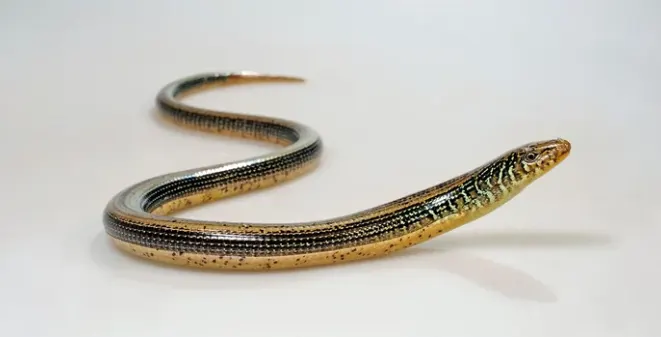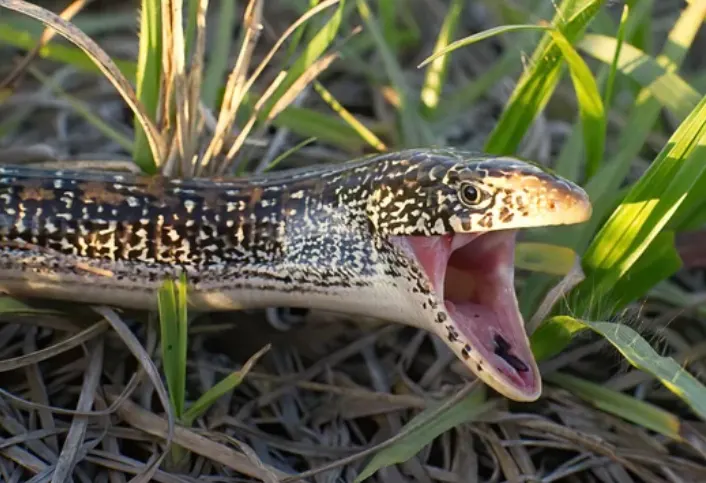Imagine spotting a creature that looks like a snake but isn’t quite one. Meet the Eastern Glass Lizard (Ophisaurus ventralis)—a remarkable legless lizard that has captivated animal lovers and researchers alike. Despite its snake-like appearance, this fascinating reptile belongs to the lizard family and offers many surprises.

Let’s dive into the fascinating world of the Eastern Glass Lizard!
Table of Contents
Top 5 Fascinating Facts About the Eastern Glass Lizard
- It’s Not a Snake!
Although it’s often mistaken for a snake, the Eastern Glass Lizard has ears and blinks, which snakes can’t do. These subtle differences make this lizard an enigma to those who spot it in the wild. - Tail of Glass: The Great Escape
When threatened, this lizard detaches its tail to escape predators. The tail may even break into pieces—hence the “glass” in its name. Over time, the tail grows back, but the new one is often shorter and lacks the original markings. - A Living Fossil
Before 1954, all glass lizards were thought to be a single species. Now, the Eastern Glass Lizard holds the title as the longest and heaviest in its family. - Green Beauty
It’s the only species in the Ophisaurus genus with green coloration, adding to its unique appearance. - Survivor of the Roads
Unlike snakes that slither smoothly, this lizard relies on pushing off nearby objects to move. Being stranded on smooth surfaces like highways can be dangerous and difficult for it to navigate.
Scientific Classification: A Glimpse into Its Origins
The scientific name of the Eastern Glass Lizard, Ophisaurus ventralis, gives away much about its nature.
- Ophisaurus: Derived from Greek, where ophio means snake and sauros means lizard.
- Ventralis: Latin for “of the belly,” referring to how this lizard moves.
Despite its snake-like name, the Eastern Glass Lizard is every bit a lizard, showing us how nature can blur the lines between species!
Physical Appearance: How to Spot This Legless Lizard
At first glance, the Eastern Glass Lizard’s long, slender, legless body makes it easy to confuse with a snake. However, a closer look reveals several distinct features:
- Length: Ranging from 18 to 43 inches long, with most of the length coming from its tail.
- Ear Openings and Eyelids: These features separate it from snakes, which lack external ears and blinking eyes.
- Scales: Smooth, glossy, and in beautiful shades of brown, green, tan, and white. The belly is usually white and unmarked.
One thing to note is the lateral groove running down the sides of its body, which is unique to this species. Adult Eastern Glass Lizards often have white marks around their head and neck, while younger ones show stripes that fade as they grow.
Where Can You Find the Eastern Glass Lizard?
The Eastern Glass Lizard is native to the southeastern United States, thriving in various wet habitats, including:
- Marshes
- Forests near oceans
- Moist grasslands
- Coastal dunes
It’s a burrower by nature and is often spotted under trash, flower pots, or discarded boards. This lizard loves wet, humid environments and is most active during the day and at dusk.
Diet: A Carnivore with an Appetite
As a carnivore, the Eastern Glass Lizard feeds on a variety of prey:
- Insects like crickets and grasshoppers
- Spiders and earthworms
- Bird eggs
- Small reptiles, including other lizards
Since it cannot unhinge its jaw like a snake, its diet consists of prey small enough to fit within its mouth.
Predators and Threats: Living on the Edge
Despite its impressive ability to escape, the Eastern Glass Lizard faces several natural and human threats:
- Predators: Birds of prey, foxes, raccoons, and snakes are among the most common threats to the Eastern Glass Lizard. Even wild pigs will eat their eggs!
- Vehicular Accidents: Since this lizard doesn’t slither, moving across smooth surfaces like highways can be dangerous, often resulting in fatal accidents.
- Habitat Destruction: Human development and climate changes also pose a significant threat to their natural habitats.
Life Cycle: From Egg to Independence
Eastern Glass Lizards breed in the spring, with females laying anywhere from 5 to 15 eggs during the summer. After laying, the female coils around her eggs to protect them, though she won’t aggressively defend them.
- Incubation: The eggs hatch after 50 to 60 days, and the young lizards—called hatchlings—are immediately independent.
- Size at Birth: Hatchlings are about 6 to 8 inches long and tan-colored, with dark stripes along their bodies that fade as they mature.
Eastern Glass Lizards can live up to 30 years, making them one of the longer-lived reptiles in their range.
Conservation Status: Holding Steady
Currently, the Eastern Glass Lizard is classified as Least Concern by conservationists. Though their population numbers aren’t precisely known, these reptiles are widespread throughout their range.
Why Keep an Eastern Glass Lizard as a Pet?
For reptile enthusiasts, the Eastern Glass Lizard makes a fascinating, albeit challenging, pet. Here are some tips for caring for one:
- Habitat: Provide a large enclosure with UVB light and a basking area of about 90°F.
- Substrate: Choose a burrow-friendly material about 4 inches deep for digging.
- Humidity: Maintain around 65 to 75% humidity, with misting twice a day.
- Diet: Feed them smaller insects, such as mealworms, crickets, and grasshoppers, dusted with vitamins and minerals.
- Water: Make sure the lizard has access to fresh water at all times.
Note: These lizards don’t enjoy being handled and may even bite if surprised, so handling should be minimal.

The Curious Name: Why “Glass” Lizard?
The “glass” in its name refers to the fragile tail that can shatter into pieces when the lizard is caught by a predator. This feature doesn’t harm the lizard—on the contrary, it gives them a chance to escape.
Over time, they can regrow their tail, but it often appears shorter and lacks the vibrant markings of the original.
A True Survivor
The Eastern Glass Lizard is a remarkable reptile that breaks the mold of what we typically think a lizard should be. From its snake-like appearance to its glass-like tail, this legless lizard continues to intrigue researchers and reptile lovers alike.
So, the next time you come across a “snake” in the southeastern U.S., take a closer look—it might just blink back at you!
The Eastern Glass Lizard is proof that nature loves to surprise us, blurring the boundaries between species and challenging what we think we know about reptiles. Wouldn’t it be exciting to spot one of these elusive creatures on your next adventure?
- Enchi Ball Python: A Unique and Stunning Morph of Python regius - March 27, 2025
- Emerald Tree Monitor: The Enigmatic Green Guardian of the Rainforest - March 26, 2025
- The Egyptian Cobra (Naja haje): A Fascinating Serpent - March 25, 2025
